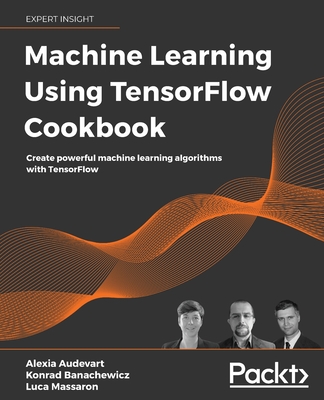Applied Deep Learning with Python: Use scikit-learn, TensorFlow, and Keras to create intelligent systems and machine learning solutions
Alex Galea, Luis Capelo
- 出版商: Packt Publishing
- 出版日期: 2018-08-31
- 定價: $1,715
- 售價: 9.5 折 $1,629
- 語言: 英文
- 頁數: 334
- 裝訂: Paperback
- ISBN: 1789804744
- ISBN-13: 9781789804744
-
相關分類:
DeepLearning、Python、程式語言、TensorFlow、Machine Learning
-
相關翻譯:
Python 深度學習應用 (Applied Deep Learning with Python: Use scikit-learn, TensorFlow, and Keras to create intelligent systems and machine learning solutions) (簡中版)
立即出貨 (庫存=1)
買這商品的人也買了...
-
 SELinux: NSA's Open Source Security Enhanced Linux (Paperback)
SELinux: NSA's Open Source Security Enhanced Linux (Paperback)$1,570$1,492 -
 $1,715Introduction to Algorithms, 3/e (Hardcover)
$1,715Introduction to Algorithms, 3/e (Hardcover) -
 Effective Python: 59 Specific Ways to Write Better Python (Paperback)
Effective Python: 59 Specific Ways to Write Better Python (Paperback)$1,690$1,606 -
 ZigBee 技術開發 — Z-Stack 協議棧原理及應用
ZigBee 技術開發 — Z-Stack 協議棧原理及應用$234$222 -
 $1,617Deep Learning (Hardcover)
$1,617Deep Learning (Hardcover) -
 $1,088D3.js 4.x Data Visualization, 3/e (Paperback)
$1,088D3.js 4.x Data Visualization, 3/e (Paperback) -
 資料結構 -- 使用 Python
資料結構 -- 使用 Python$520$411 -
 Python Testing with Pytest: Simple, Rapid, Effective, and Scalable
Python Testing with Pytest: Simple, Rapid, Effective, and Scalable$1,790$1,701 -
 $403OpenStack 高可用集群 (下冊):部署與運維
$403OpenStack 高可用集群 (下冊):部署與運維 -
 $1,248Pandas for Everyone: Python Data Analysis (Addison-Wesley Data & Analytics Series)
$1,248Pandas for Everyone: Python Data Analysis (Addison-Wesley Data & Analytics Series) -
 駭客的修練|使用 IDA Pro 進行底層分析, 2/e
駭客的修練|使用 IDA Pro 進行底層分析, 2/e$480$379 -
 Neo4j 圖形資料庫權威指南 -- 傲視大數據時代的先端利器
Neo4j 圖形資料庫權威指南 -- 傲視大數據時代的先端利器$650$553 -
 $1,782Flask Web Development : Developing Web Applications with Python, 2/e (Paperback)
$1,782Flask Web Development : Developing Web Applications with Python, 2/e (Paperback) -
 $374Python 絕技 : 運用 Python 成為頂級數據工程師
$374Python 絕技 : 運用 Python 成為頂級數據工程師 -
 $403Python 數據分析 : 基於 Plotly 的動態可視化繪圖
$403Python 數據分析 : 基於 Plotly 的動態可視化繪圖 -
 $960Clean Code in Python: Refactor your legacy codebase (Paperback)
$960Clean Code in Python: Refactor your legacy codebase (Paperback) -
 Python 數據可視化之 matplotlib 實踐
Python 數據可視化之 matplotlib 實踐$354$336 -
 $1,862Machine Learning Algorithms: Popular algorithms for data science and machine learning, 2nd Edition
$1,862Machine Learning Algorithms: Popular algorithms for data science and machine learning, 2nd Edition -
 一直學不會 Tensorflow? PyTorch 更好用更強大更易懂!
一直學不會 Tensorflow? PyTorch 更好用更強大更易懂!$540$459 -
 $998Hands-On Data Visualization with Bokeh: Interactive web plotting for Python using Bokeh
$998Hands-On Data Visualization with Bokeh: Interactive web plotting for Python using Bokeh -
 物件導向 ANSI-C 與 Python 的結合
物件導向 ANSI-C 與 Python 的結合$490$441
相關主題
商品描述
A hands-on guide to deep learning that's filled with intuitive explanations and engaging practical examples
Key Features
- Designed to iteratively develop the skills of Python users who don't have a data science background
- Covers the key foundational concepts you'll need to know when building deep learning systems
- Full of step-by-step exercises and activities to help build the skills that you need for the real-world
Book Description
Taking an approach that uses the latest developments in the Python ecosystem, you'll first be guided through the Jupyter ecosystem, key visualization libraries and powerful data sanitization techniques before we train our first predictive model. We'll explore a variety of approaches to classification like support vector networks, random decision forests and k-nearest neighbours to build out your understanding before we move into more complex territory. It's okay if these terms seem overwhelming; we'll show you how to put them to work.
We'll build upon our classification coverage by taking a quick look at ethical web scraping and interactive visualizations to help you professionally gather and present your analysis. It's after this that we start building out our keystone deep learning application, one that aims to predict the future price of Bitcoin based on historical public data.
By guiding you through a trained neural network, we'll explore common deep learning network architectures (convolutional, recurrent, generative adversarial) and branch out into deep reinforcement learning before we dive into model optimization and evaluation. We'll do all of this whilst working on a production-ready web application that combines Tensorflow and Keras to produce a meaningful user-friendly result, leaving you with all the skills you need to tackle and develop your own real-world deep learning projects confidently and effectively.
What you will learn
- Discover how you can assemble and clean your very own datasets
- Develop a tailored machine learning classification strategy
- Build, train and enhance your own models to solve unique problems
- Work with production-ready frameworks like Tensorflow and Keras
- Explain how neural networks operate in clear and simple terms
- Understand how to deploy your predictions to the web
Who this book is for
If you're a Python programmer stepping into the world of data science, this is the ideal way to get started.
Table of Contents
- Jupyter Fundamentals
- Data Cleaning and Advanced Machine Learning
- Web Scraping and Interactive Visualizations
- Introduction to Neural Networks and Deep Learning
- Model Architecture
- Model Evaluation
- Productization











